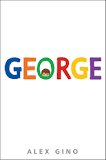“George” by Alex Gino
Gino, Alex. George. New York: Scholastic Press, 2015.
Age Range: 8–12
Lexile: 790
Summary: This is the story of Melissa, whose friends and family know her as George. This is a novel about a transgender boy who identifies as a female. George thinks she'll have to keep this a secret forever. Then her teacher announces that their class play is going to be Charlotte's Web. George really, really, REALLY wants to play Charlotte. But the teacher says she can't even try out for the part because she's a boy. With the help of her best friend, Kelly, George devises a plan so everyone can know the real her once and for all.
Book Selling Tool: Infographic
Activity: Being an Ally:
Students will first be asked to think, What is an ally? and,What are some examples of ally behavior you have seen in school? What are examples of ally behavior in the book?
Students will then, brainstorm characters in the book who displayed “ally” behavior. These could include George’s best friend Kelly, George’s brother Scott, Principal Maldonado. Students will each get an Ally worksheet
Students will go through the book and jot down as many instances of ally behavior that that they can quotes, actions, etc. and apply them to create real world examples. As a culmination, students will work in groups to express their knowledge on Ally’s with illustrate their examples of ally behavior by creating a final project which could an Imovie or
Groups will respond to each others presentations through a peer feedback rubric in which they agree or disagree with each group's definition, example from book, and real world connections and explain why or why not.
Standards:
Key Ideas and Details:
Cite textual evidence to support analysis of what the text says explicitly as well as inferences drawn from the text.
.
AASL:
2.1.3 Use strategies to draw conclusions from information and apply knowledge to curricular areas, real world situations, and further investigations.
2.1.5 Collaborate with others to exchange ideas, develop new understandings, make decisions, and solve problems.
Information Literacy:
6.4 Presents conclusions and supporting facts in a variety of ways.
Learning Outcomes: Students will use evidence from the text (quotes or examples) to make real world connections of what an ally is and how a person can be one. They will then create IMovies or an Animaker to connect all of their ideas for what makes an Ally (using support from the book plus their own real world scenarios).
Learning Objectives
Students will identify 4 quotes/examples from the text and analyze how those examples contribute to real world applications of being an ally (Cognitive).
Students will create an Imovie or an Animaker and assess each of their peers presentations for feedback and clarification on own definition of what being an ally means (Psychomotor, Affective).
Assessments
Student created Imovie
Student Peer Feedback Rubric
Work Cited:
Anti-Defamation League. ADL's Book of the Month: George. 2016. Retrieved on November 6th from https://www.adl.org/sites/default/files/documents/assets/pdf/education-outreach/book-of-the-month-george.pdf
Student Peer Feedback Rubric
Work Cited:
Anti-Defamation League. ADL's Book of the Month: George. 2016. Retrieved on November 6th from https://www.adl.org/sites/default/files/documents/assets/pdf/education-outreach/book-of-the-month-george.pdf
No comments:
Post a Comment